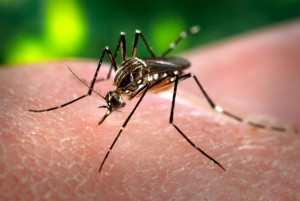This is a guest blog article by Dr. Julien Pelletier, School of Life Sciences, Keele University

Mosquitoes rely heavily on their sense of smell as it provides a highly efficient link between volatile odors (ligands) from the environment and critical behaviors such as host-seeking. Molecular mechanisms of olfaction take place in olfactory receptor neurons (ORNs) housed in the antennae and
maxillary palps. A diverse array of proteins has been shown to play a role in odor detection in mosquitoes, including different families of
receptors that are known to interact with specific sets of ligands. The democratization of genome-editing techniques based on engineered nucleases offers new ways of uncovering the precise contribution of olfactory proteins to mosquito behaviors. Researchers at The Rockefeller University in New York are currently exploiting these novel tools to dissect the host-seeking mechanisms in the highly anthropophilic mosquito Aedes aegypti, an important vector for dengue and yellow fever.
In a first study, the authors focused on the large odorant receptor (Or) family (~130 genes), a main contributor to the olfactory sense in insects. By knocking-out the odorant receptor co-receptor (orco) necessary for proper functioning of other ligand-binding subunits, they disrupted the entire Or pathway, including Ors tuned specifically to human odors. Behavioral assays revealed that mutant mosquitoes were not attracted to a human odor extract, when compared to wild-type controls. However, attraction to human scent could be restored in mutants in the presence of CO2, demonstrating that an additional host-derived cue is sufficient to trigger host-seeking behavior without a functional Or pathway. Importantly, orco mutants were not preferentially attracted to humans when presented with an alternative rodent host, indicating that OR-mediated detection of odors is playing a key role in host choice.
It is well known how CO2, a widely employed mosquito attractant, stimulates host-seeking activity. In a second study published recently by the same group, an identical approach was used to knock-out a gustatory receptor (Gr) subunit, Gr3, expressed in the CO2-sensitive ORN called cpA. Gr3 mutants, rendered insensitive to CO2, lacked the typical flight activation pattern, confirming the role of CO2 as behavioral stimulator. As expected, mutant and wild-type mosquitoes were similarly attracted to a human odor extract and the addition of CO2 increased the attraction only in the wild-type insects. However, both genotypes remained strongly attracted to a real human arm, suggesting that additional stimuli (heat, moisture, additional odors not present in the extract or visual cue) can overcome the lack of CO2 sensitivity. Building upon this discovery, the authors designed a blood-feeding behavioral assay where different combinations of sensory cues could be tested. Mutant mosquitoes displayed robust blood-feeding activity when the source of blood was heated to physiological body temperature and presented together with human scent, but not when the blood was heated and presented together with CO2. In contrast, wild-type animals fed on blood when at least two host cues were combined (e.g., body heat with human odor or CO2). Taken together, it is likely that each binary combination of host cues is sufficient to elicit blood-feeding behaviors in mosquitoes. To understand the significance of such a discovery, mosquito attraction to humans was studied on a larger scale using an environment designed to mimic a real human habitat (i.e., a dwelling plus an outdoor yard).

Equal numbers of mutant and wild-type insects were released into the test area, and the number of landings on a human volunteer was compared across genotypes. Interestingly, almost no differences were observed, suggesting that abolishing the CO2 pathway is not sufficient to significantly reduce mosquito bites.
These studies provide fundamental insights into the molecular mechanisms of host-seeking behavior. The authors demonstrated the extreme efficiency of mosquitoes to exploit a combination of distinct host-derived cues to obtain a blood-meal, indicating that future olfactory-based control strategies should be geared towards multiple sensory pathways. The functional dissection of host-seeking behavior at the molecular level is far from complete and should expand to a third family of chemoreceptors, the ionotropic receptors (Irs), as well as to different types of highly abundant soluble chemosensory proteins. The development of genetic tools in mosquitoes provides unique opportunities to decipher the contribution of olfactory proteins to host-seeking and other important behaviors and paves the way towards future applications to control mosquito populations.

One Comment